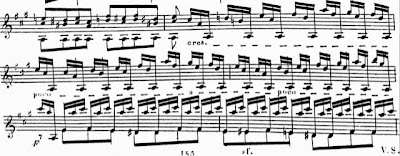It is difficult to find a piece in the guitar repertoire that doesn't, at some point, contain two or more simultaneous parts. Such musical environments require clarity so listeners can discern which notes are important and which are merely supportive. The ability to reliably play one note loudly while simultaneously playing other notes softly is central to classical guitar technique. I call this "balance," borrowing the term from the audio engineer's world. Picture being at the mixing board (or pro tools interface) and moving the slider up for the vocals and pulling back the level on the rhythm guitar and piano. You are looking for the perfect mix, a balance, in which relatively unimportant material (strummed chords, for instance) is set low and important material (the lead vocal, say) is set high.
The band is lucky to have a sound man on site for the gig, or a professional at the controls for setting the mix in a recording.
We classical guitarists have only our ears and our right hands.
Fundamentally, there are two techniques at play here. One is the ability to play certain notes in a sequence louder while the rest are soft; in this case the notes are sounded individually, as in an arpeggio. The other, more difficult, technique is producing distinctly different levels at the same time, as in a block chord sequence with a melodic note on top.
In one sense, this technique alone sets the classical guitarist apart from our brethren in other styles (you can't get clarity of counterpoint with a flatpick). Without mastery of balance, guitarists always sound to me like visitors to classical music, not actual residents.
So, how do you do it?
In this post I'll address the first of the two techniques in question. (The other, in a follow-up post).
Most of the classical period studies we play when starting guitar are designed to address this problem. Therefore, students get plenty of opportunity to master it, early. In spite of this fact, many don't, and few do sufficiently.
Take this Carcassi study for example.
It seems obvious that the musical texture requires a subtle control of three voices: a treble-bass melodic dialogue with a quiet, supportive inner part. Most students, though, will accept an all-notes-equal arpeggio as stage-ready. When the inner part (i-m) is played REALLY softly, almost imperceptibly, and the treble and bass are played with real dynamic shaping, then it sounds like a true, classical, multi-part texture--much more interesting than a simple arpeggio and true to the composer's intentions (as indicated by stemming).
The same holds true for this universal starter piece, Sor's Étude, Op 35, No. 22 (Segovia No. 5). How many times have we heard it as an all-notes-equal arpeggio, and how lovely is it when the balance is controlled? (There are two melody notes/measure).
This challenge is so ubiquitous in our repertoire, it is hard to find a piece that doesn't require it. Take this chestnut by Tarrega (Lagrima). If the open b's are played quietly enough, then it emerges as truly melodic.
In the opening of the Allegro in Barrios' La Catedral, lightening up the touch on the offbeat f#-e#'s enables the presentation of the tune with clarity:
In Dreaming, a movement from Britten's Nocturnal, the same challenge awaits, now all in harmonics:
What is hard to convey adequately is the degree of extreme that is possible in these and similar figures. The supportive notes can be played REALLY softly. Almost imperceptibly. And the result is great: perfect clarity of texture.
In the Giuliani Rossiniane Op 121, the following passage can vex the right hand if all notes are played with equal force. Allowing the relatively slow and simple tune to show by playing the accompanying notes quietly makes playing it fast much easier:
Another problem spot in the Giuliani oeuvre is this ascending melodic arpeggio from the Grand Overture. Focus on the rising notes with m, on the beat, and play the other two notes quietly. It'll sound better and be much easier:
This passage from the La Harpe du Guerrier, from Le Decameron Noir of Brouwer, has clear melodic intent, if inconsistently indicated in the notation:
The bonus from working on balance that the player experiences is a wonderful discovery: the music becomes EASIER. Any time you play a note softly, in takes less energy, less "muscle." In faster passages, it is often the case that half or more of the notes are actually quiet ones, effectively reducing by half the difficulty of the passage; the Barrios is a case in point. Your speed will increase when the number of notes you play loud decreases. Do this sensibly and your pieces become more musical, more "classical," more correct AND easier. Nice!
Next Balance post: music of Bach.








